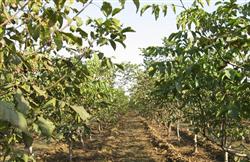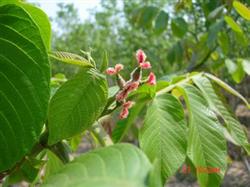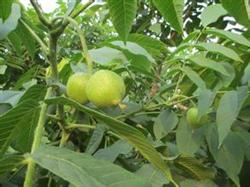How to control Sclerotinia root rot of walnut seedlings?

Sclerotinia root rot is also called white silk disease, which damages seedlings for one year, rotting the main root and lateral root cortex, dying the ground, or even all of them. 1. Disease symptoms: At high temperature and high humidity, white silk mycelium was produced at the root neck of seedlings and surrounding soil and on the surface of fallen leaves, and then small sclerotia grew. Pathogen overwinters on diseased plant residues and soil, mostly invades from seedling neck, encounters high temperature, high humidity when the disease is serious, generally starts to occur in late May, June to August is the peak period of disease, seedlings are easy to occur on soil sticky, acidic soil or previous vegetables, grain and other plots. 1) Select nursery land, avoid continuous cropping of disease nursery, select nursery land with good drainage and low groundwater level, adopt high seedbed for cultivation in rainy area 2) Air soil or change soil with sand, change soil once a year, usually 1-2 times effective 3) Seed disinfection and soil treatment, dressing seeds with 50% carbendazim powder 0.3% before sowing, adding lime or plant ash to acidic soil appropriately to neutralize acidity, reducing disease incidence, in addition, The root of diseased tree was irrigated with 500-1000 times solution of 1% copper sulfate or thiophanate-methyl, and the base of seedling neck was sprinkled with hydrated lime, or the soil was irrigated with 1000 times solution of thiophanate-methyl.
- Prev

Control of Carya cathayensis Flower Bud maggot
Carya cathayensis flower bud maggot is the main pest that harms the flower bud of Carya cathayensis. Because the insect is small and concealed, the occurrence period is short, and the harm is serious, once the effective control period is lost, the yield of Carya cathayensis will be seriously affected. In order to effectively guarantee the output of pecans this year, scientific and technological personnel put forward on how to carry out effective prevention and control: first, we should pay attention to.
- Next

Main technical measures for cultivating thick and strong seedlings of Carya cathayensis
In recent years, many farmers are optimistic about the planting of flax walnut trees, but they know little about their planting techniques. Not long ago, some fruit farmers asked about the irrigation of flax walnut trees. The author believes that if you want to plant a good flax walnut tree, there can be no shortage of water for five times. Water for the first time. In a year with normal rainfall, the first water is in late March, said.
Related
- Moge, come on! The staff of the peasant association in the producing area of cantaloupe were frightened when the crowd gathered.
- Causes and Solutions of low Fruit setting rate of Apple
- Symptoms and control measures of passion fruit virus disease
- Fruit growing lesson: how do apple orchards keep high yields?
- Can you build orchards in the mountains? What are the pros and cons?
- How to manage the coloring period of Crisson grape?
- This paper introduces the processing technology of two kinds of fig products.
- How much is a month for retired teachers in rural areas by 2020?
- How can strawberry planting increase sugar content? We should pay attention to management in many aspects.
- What are the cultivation techniques on how to improve the yield of golden fruit?

